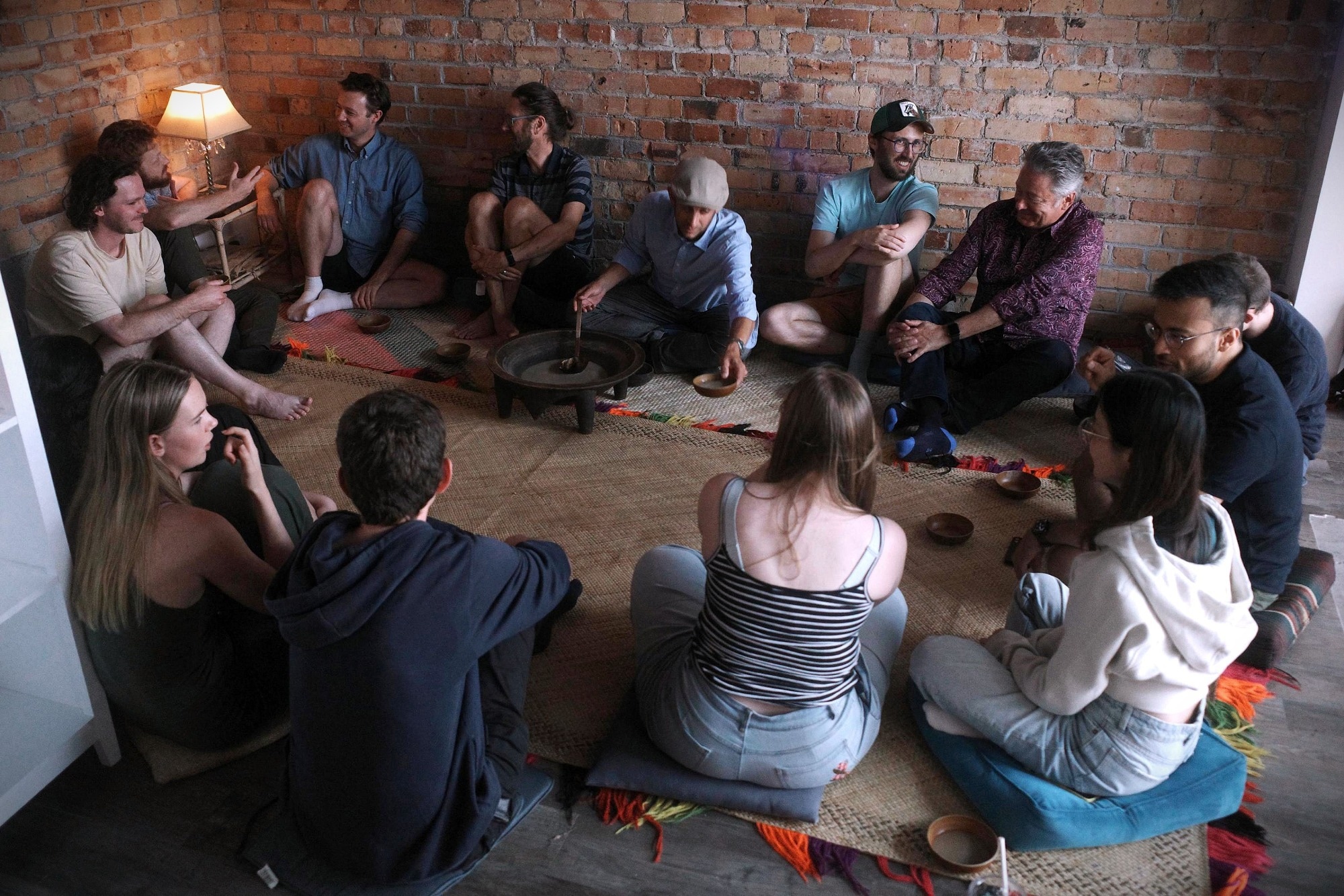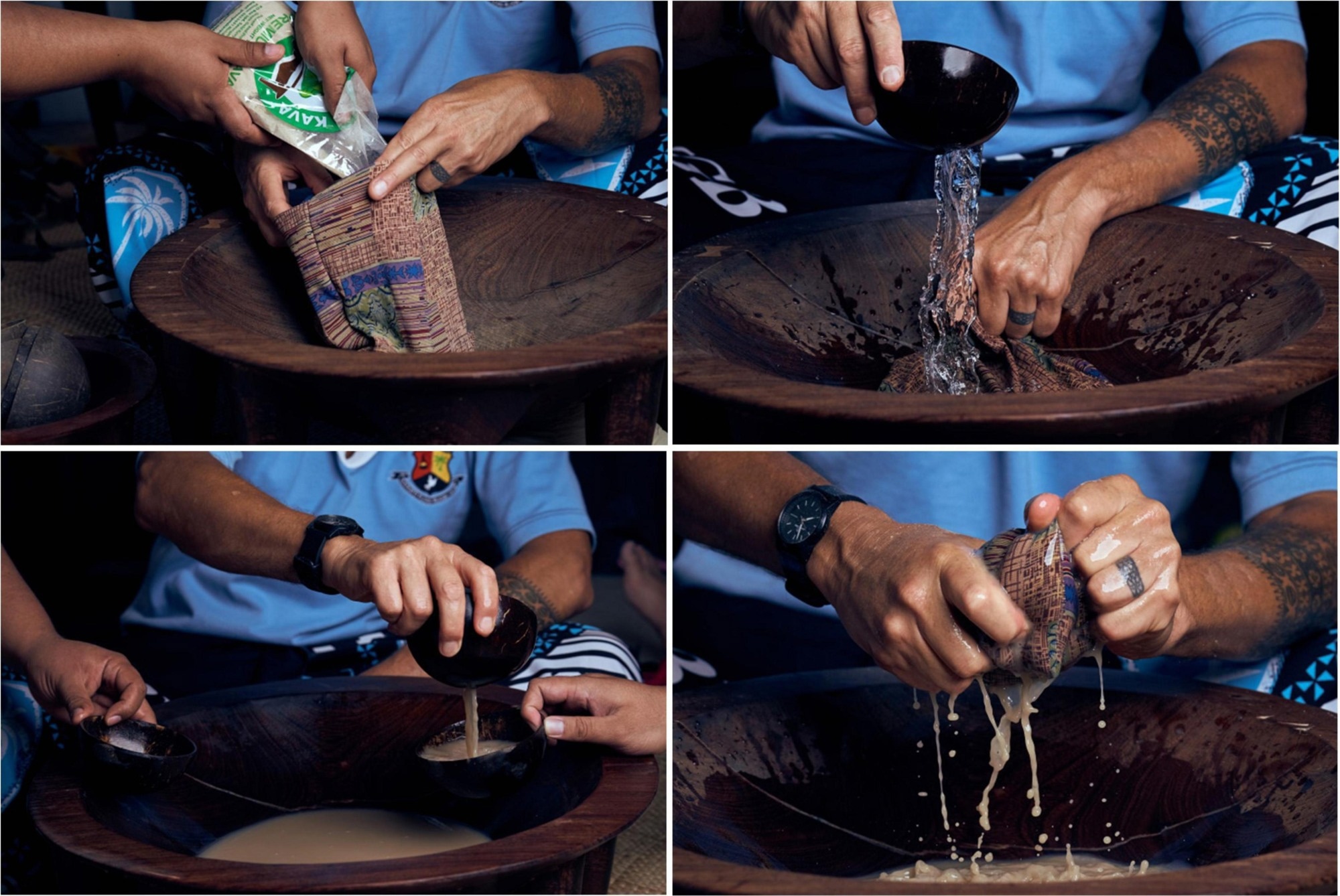New research explores how the Pacific traditions of kava drinking and talanoa storytelling could transform PTSD care, offering hope and healing where Western therapies have fallen short.
 Mixed ethnicity kava users seated on fala/ibe (woven mats) and engaging in talanoa in Tāmaki Makaurau, Auckland, Aotearoa New Zealand. Reproduced with permission from photographer: Todd M. Henry, 2022.
Mixed ethnicity kava users seated on fala/ibe (woven mats) and engaging in talanoa in Tāmaki Makaurau, Auckland, Aotearoa New Zealand. Reproduced with permission from photographer: Todd M. Henry, 2022.
Nearly 80% of Maori veterans in New Zealand report trauma-related symptoms such as anxiety and post-traumatic stress disorder (PTSD), but current PTSD and anxiety medications are associated with high addiction risks and offer only short-term relief.
In a recent study published in the journal Frontiers in Psychology, researchers reviewed evidence, including qualitative and pilot data, supporting a culturally grounded alternative for treating PTSD that combines the traditional Pacific drink kava with talanoa. Talanoa is a traditional word used in Fiji and across the Pacific to reflect a process of inclusive, participatory, and transparent dialogue. The study examined whether kava-talanoa can provide safer, longer-lasting therapeutic benefits based on pilot experiences, with a clinical trial planned for 2025. It is important to note that this review is not a systematic review or meta-analysis, but synthesizes published literature, case studies, and experiential evidence.
Trauma-associated disorders
PTSD is a growing global health concern that affects not only military personnel and first responders but also communities facing climate disasters, pandemics, and long-standing inequality. Common treatments for PTSD include medications and cognitive-behavioral therapy (CBT). However, medications like benzodiazepines often cause addiction, have limited long-term effects, and may not suit older adults or indigenous populations. Moreover, CBT, while helpful, is usually not culturally relevant or accessible to many patients, especially Pacific peoples.
In these communities, mental health care is hindered by systemic racism, poor access to services, and a mismatch between Western treatments and cultural values. These gaps have created an urgent need for safer, more effective, and culturally respectful alternatives. Traditional approaches that promote relaxation, sleep, and meaningful conversation, such as the Pacific practices of kava drinking and talanoa storytelling, may fill this void.
Exploring traditional therapies for PTSD
In this review, the research team proposed a novel therapeutic approach that combines kava, a traditional Pacific beverage, with talanoa, a culturally grounded form of dialogue. Kava is derived from the root of the Piper methysticum plant and contains natural compounds called kavalactones, which may interact with the γ-aminobutyric acid (GABA) receptors in the brain, similar to anti-anxiety medications, but without the risk of addiction or cognitive impairment. The talanoa component involves open, respectful conversation that promotes emotional sharing and collective understanding.
 Kava mixing and serving in Tāmaki Makaurau Auckland, Aotearoa New Zealand. Clockwise: 1. dried and pounded kava powder is added to the silk mixing bag; 2. water is added to the tanoa or kumete (traditional kava bowl); 3. the kava (in the mixing bag) is washed through the water until the desired concentration is achieved; 4. the kava is served in ipu/bilo (cups made from half-coconut shells). Photographer: Todd M. Henry, 2019.
Kava mixing and serving in Tāmaki Makaurau Auckland, Aotearoa New Zealand. Clockwise: 1. dried and pounded kava powder is added to the silk mixing bag; 2. water is added to the tanoa or kumete (traditional kava bowl); 3. the kava (in the mixing bag) is washed through the water until the desired concentration is achieved; 4. the kava is served in ipu/bilo (cups made from half-coconut shells). Photographer: Todd M. Henry, 2019.
The proposed kava-talanoa sessions, modeled on documented traditional practices, would reflect the naturalistic use of kava, where participants would sit on woven mats, drink kava from coconut-shell cups, and engage in guided conversations within culturally respectful environments. These sessions aim to foster a sense of safety and community, potentially key to addressing PTSD symptoms such as avoidance, emotional suppression, and sleep problems.
To gather preliminary insights, the researchers collected qualitative data from Pacific veterans, first responders, and civilians who had used kava-talanoa informally to manage their trauma. Reports were drawn from interviews, personal accounts, and therapist observations. They also compared the impact of kava-talanoa with alcohol use.
Key findings from pilot experiences
Anecdotal evidence suggested that kava-talanoa may reduce symptoms of post-traumatic stress among participants, particularly in Pacific populations. This combination therapy provided a culturally familiar and emotionally safe environment for individuals to process trauma. Pilot participants reported improvements in sleep quality, reduced anxiety, and an enhanced ability to engage in therapeutic conversations.
Veterans and first responders who had previously struggled with avoidance behaviors described feeling more comfortable discussing painful experiences during kava-talanoa sessions. They reported a sense of calm and emotional clarity after these gatherings. The long-lasting relaxing effects of kava appeared to facilitate deeper conversations, while talanoa provided a non-judgmental space for storytelling and emotional connection. Unlike alcohol, which often intensified aggression and emotional distress, kava seemed to encourage peaceful reflection and community bonding.
Many participants described finally being able to fall asleep and stay asleep through the night without flashbacks. This restorative sleep was associated with better mood, cognitive functioning, and overall well-being.
The review also highlighted differences between naturalistic kava and commercially extracted forms of kava. Traditional aqueous kava, consumed in communal rituals, appeared to preserve therapeutic compounds and cultural meanings that enhanced its effectiveness. In contrast, chemically processed kava products did not yield comparable benefits in informal settings.
Based on these pilot insights, the team has designed a clinical trial supported by New Zealand’s Health Research Council. The trial, scheduled to begin in mid-2025, will compare traditional kava beverages and capsules to determine the optimal dosage and efficacy, and will assess cultural adaptability across Pacific and non-Pacific participants, with parallel research arms in the United States and Europe.
Conclusions
The review concluded that kava-talanoa is a promising, culturally respectful therapy for PTSD. By blending traditional Pacific practices with modern therapeutic goals, it offers a meaningful alternative to conventional treatments, which come with numerous adverse effects, such as addiction.
Pilot participants described greater emotional relief, improved sleep, and deeper connection through this approach. However, it is important to emphasize that these conclusions are preliminary and based on pilot and anecdotal data. As full clinical validation is pending, these preliminary findings suggest that culturally aligned therapies like kava-talanoa could play a vital role in global mental health care, especially for Pacific and Indigenous communities where Western therapies have fallen short.
Journal reference:
- Aporosa, S. A., Itoga, D., Ioane, J., Prosser, J., Vaka, S., Grout, E., Atkins, M. J., Head, M. A., Baker, J. D., Blue, T., Sanday, D. H., Owen, M. W., Murray, C., Sivanathan, K., Cuthers, Tua’ipulotu W., Mesui-Henry, A., McCarthy, M.-J., Bunn, J., Waqainabete, I., & Turner, H. (2025). Innovating through tradition: Kava-talanoa as a culturally aligned medico-behavioral therapeutic approach to amelioration of PTSD symptoms. Frontiers in Psychology, Volume 16. doi:10.3389/fpsyg.2025.1460731, https://www.frontiersin.org/journals/psychology/articles/10.3389/fpsyg.2025.1460731/full